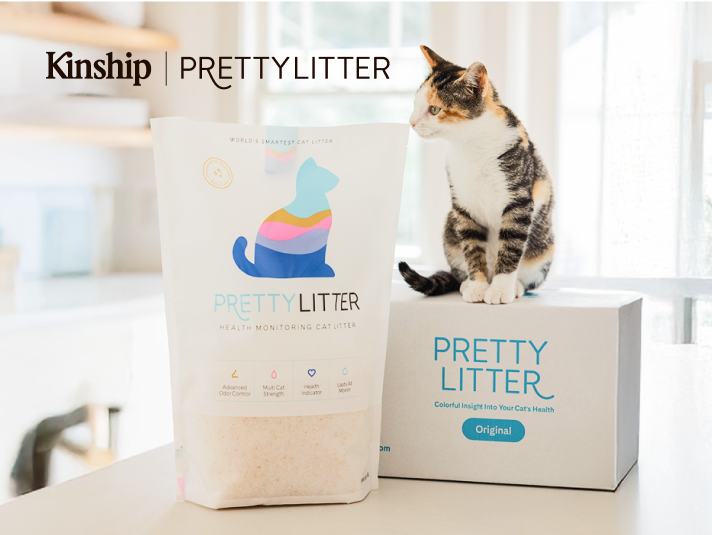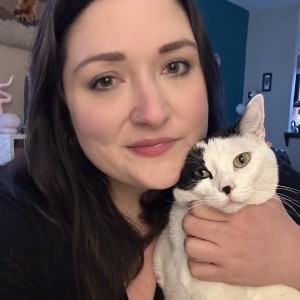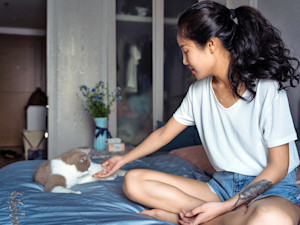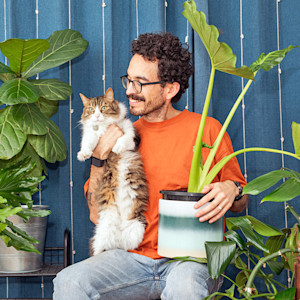The Real Reason Your Cat Makes That “Stink Face”
It’s definitely not because you disgust them.

Share Article
You may have seen a video like this on social media: One cat is sniffing another cat’s butt, when suddenly they make a funny face (they pull up their lip and show off their whole mouth), as if they’re saying “Dude, you stink!” We humans are likely to find this peculiar behavior amusing and relatable (as a New Yorker, I can say I have definitely made that same face at someone else’s butt-smell on the subway), so you might be surprised to learn what the feline “stink face” actually means, and the reason why cats make it.
First of all, the expression pet parents might callopens in a new tab “stink face” actually has a proper scientific name: the flehmen response. This name is derived from the German word opens in a new tab“flemmen,” which means “to curl the upper lip.” And it’s not unique to felids (members of the cat family), either. It’s also performed by ungulates (mammals with hooves like horses, sheep, and deer).

Save on the litter with color-changing tech that helps you better care for your cat.
And while cat parents may be surprised to find out their pet has something in commonopens in a new tab with a rhinoceros, the flehmen response presents much the same in all the species that exhibit the behavior. In each of these animals, the top lip curls back to reveal the animal’s front teeth and gums, and it inhales deeply while holding itself still for a few seconds.
They may make the stink face when you’d expect them to, like when they smell pee (or any kind of stinky butt odor), dirty laundry, or another cat’s anal-gland secretionsopens in a new tab. But it could also happen any time they smell something new or exciting (tell your new S.O. they may be in for a little stink face action!).
But fear not! When they make this face, it doesn’t mean they’re disgusted with you or someone new you bring around — unless they have reason to be. Most likely, they are just experiencing a new smell, and they’re responding to it. In fact, it’s literally a natural bodily response...
Actually, your cat has an organ that causes their little lip to curl.
It turns out that when an animal is exhibiting the flehmen response, they’re using a little-known olfactory organ called the vomeronasal organ (VNO), or Jacobson's organ, which is above the roof of their mouth and just behind their front teeth. All mammals, plus snakes and lizards, have this organ, even humans have some leftover traces of oneopens in a new tab, though ours doesn’t work.
You may have already learned that a cat’s sense of smell is much, much stronger than a human’s — supposedly about 14 times strongeropens in a new tab, in fact — so it hardly seems fair that cats also have this secret “second nose.” But this organ is a necessary adaptation for cats because it specializes in the detection and analysis of a primary way cats communicateopens in a new tab: pheromones.
“We know that cats deposit pheromones from specific scent glands in their body, including ones near the genitals, but [also] their cheeks, their paws — these are always depositing pheromones,” says Mikel Delgadoopens in a new tab, a cat behaviorist and senior research scientist at Purdue University. “So, the flehmen response is information gathering — it’s just like looking at something. Their body’s just saying, ‘Hey, there’s pheromones here. Let’s check this out,’ and then it’s processing the information ... All they’re doing is drawing air and moisture into their mouth, so the [pheromone] molecules are coming in and making contact with the roof of the mouth.�”
Pheromone detection is a special ability designed to aid cats’ survival in the wild; it helps them do things like avoid another cat’s territory or find a suitable mating partner. But it’s important to domestic cats, too. You may have observed your own cat engaging in the behavior known asopens in a new tab “head bunting” or “allorubbing,” where they rub the scent glands in their body (usually their face) on objects, their cat siblings, or their human companions. The scent markings left behind by this process aren’t noticeable to us because they’re pheromonal, but it’s the cat’s way of displaying ownership of their territory or expressing affection.
Allorubbing and pheromone release also helps to create a cohesive, unified “group scent” or “colony scent.” “When [cats] live together, they tend to scratch the same things, they tend to rub on the same things, they share litter boxes,” Delgado says. “These are ways that they combine scents to basically establish a group scent, which [the scientific community] believes they identify more strongly with than their individual scent signature.”
Maybe we should find a new name for stink face.
While science has been able to nail down some information around cats’ pheromone signaling behaviors and the capabilities of the vomeronasal organ, much of it still remains unknown, and humans can merely make an educated guess. For example, we don’t yet know if the vomeronasal organ is also capable of detecting regular, non-pheromonal scents. “We know [the vomeronasal organ] is specialized for pheromone detection,” says Delgado, but “it’s an open debate as to whether or not they can actually detect other scents with this organ.”
She also points out that referring to the flehmen response as stink face is kind of a misnomer. “I think stink face is maybe not the best word to describe it,” she says. “We’re interpreting their facial expression as unpleasant, but there’s no real reason to think that what they're encountering is unpleasant to them … I think we just make a lot of assumptions that they’re experiencing the world pretty similarly to us — which is a flawed assumption.”
While this is certainly true, it’s still only natural for us to instinctively anthropomorphize our petsopens in a new tab. Faced with large gaps of knowledge about how our companions experience and process the world, we’re forced to fill in the blanks with our own human experiences. But the next time you see your cat making “stink face” at something, you’ll know a little bit more about what’s really going on — and perhaps have a new sense of appreciation for your kitty and their fascinating physiology.

Rachel Pick
Rachel Pick is a freelance writer and social media editor who has written for Vice, The Guardian, and SELF Magazine. She lives with two cats: Cricket, a genteel lady who is the picture of refinement, modesty, and good manners; and Cowboy, who is an agent of chaos, slapstick comedy, and foul odors.
Related articles
- opens in a new tab
Why Do Cats Sniff Butts?
Hey, there, dude—isn’t that a little personal?
- opens in a new tab
Why Do Cats Tuck Their Paws? The Cat Loaf Explained
It’s not just cute—it can be a sign of something more.
- opens in a new tab
Hot and Cold: Why Do Cats Give Us Such Mixed Signals?
That whole cuddle and then attack scenario, explained.
- opens in a new tab
Why Does Your Cat Smell Bad?
You love them, but oooh, boy, that is unpleasant.
![Woman trying to get her pet cat's attention at home.]() opens in a new tab
opens in a new tabThis Is the Most Effective Way to Get Your Cat’s Attention, Study Says
They can't ignore you forever.
![Man holding cat in lap while surrounded by plants.]() opens in a new tab
opens in a new tab12 Ways to Tell That Your Cat Is Happy
It’s all in the eyes... and ears and tail. And so much more.







